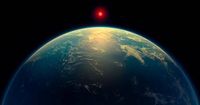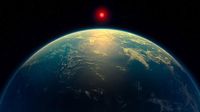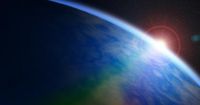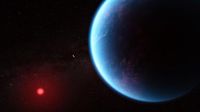On April 17, 2025, a groundbreaking discovery was announced by a team of American-British researchers regarding the exoplanet K2-18b, located 124 light-years from Earth. This planet, situated in the constellation Leo, has sparked significant debate within the scientific community due to the potential for harboring microbial life. The researchers utilized the advanced capabilities of the James Webb Space Telescope to detect chemical compounds in K2-18b's atmosphere that could indicate signs of life.
The compounds in question, dimethyl sulfide (DMS) and dimethyl disulfide (DMDS), are particularly intriguing as they are known to be produced exclusively by living organisms on Earth, primarily by phytoplankton. "What we are observing at this stage are indications of possible biological activity outside the solar system," stated Nikku Madhusudhan, an astrophysicist at the University of Cambridge and the lead author of the study published in The Astrophysical Journal Letters. He further emphasized, "To be frank, I think this is the closest case we can attribute to life."
This discovery marks a significant advancement in the search for extraterrestrial life, as it represents the most promising evidence yet of biological activity beyond our solar system. The detection of these biosignatures has reignited hopes that K2-18b could be an oceanic world capable of supporting life, a hypothesis that has been a topic of animated discussions among scientists.
However, while the findings are promising, they are not without controversy. Other scientists have urged caution, pointing out that the statistical significance of the observations currently stands at a threshold of "three sigma." This means there is a 0.3% chance that the results could be coincidental. For a discovery to be universally accepted in the scientific community, a "five sigma" significance level is typically required, indicating that the probability of chance findings would drop to less than 0.00006%.
Raymond Pierrehumbert, a professor of planetary physics at the University of Oxford, has expressed skepticism regarding K2-18b's ability to support life. He noted that the planet has a mass more than eight times that of Earth and a diameter 2.5 times larger. It orbits its star in just 33 days, leading him to conclude that if K2-18b had water, it would be a "hellish furnace, totally uninhabitable." Instead, he suggests that oceans of lava are more likely than liquid water on this distant world.
Despite these reservations, the research team remains optimistic. They believe that with an additional 16 to 24 hours of observation using the James Webb Space Telescope, they could either confirm or refute the presence of DMS and DMDS in K2-18b's atmosphere. Madhusudhan stated, "We are very cautious. We need to ask whether the signal is real and what it means. But this could be the tipping point where suddenly the fundamental question of whether we are alone in the universe is one we can answer."
The implications of these findings are vast. As scientists continue to explore the cosmos, the search for life beyond Earth remains a top priority. K2-18b's potential for supporting life adds a new dimension to our understanding of habitable environments in the universe. The ongoing research into this exoplanet may not only provide insights into the existence of extraterrestrial life but could also enhance our understanding of the conditions that foster life elsewhere.
In summary, the detection of potential biosignatures in the atmosphere of K2-18b represents a significant leap forward in astrobiology. As researchers continue to analyze the data and conduct further observations, the scientific community eagerly anticipates what these findings could mean for humanity's quest to understand its place in the universe.








